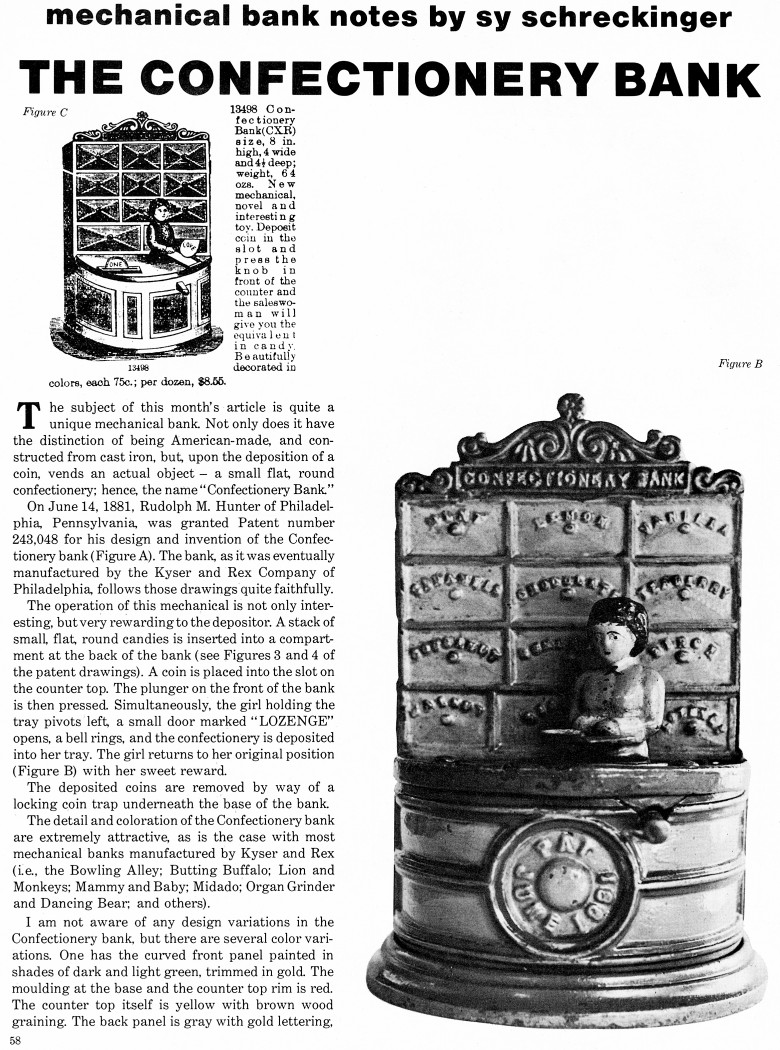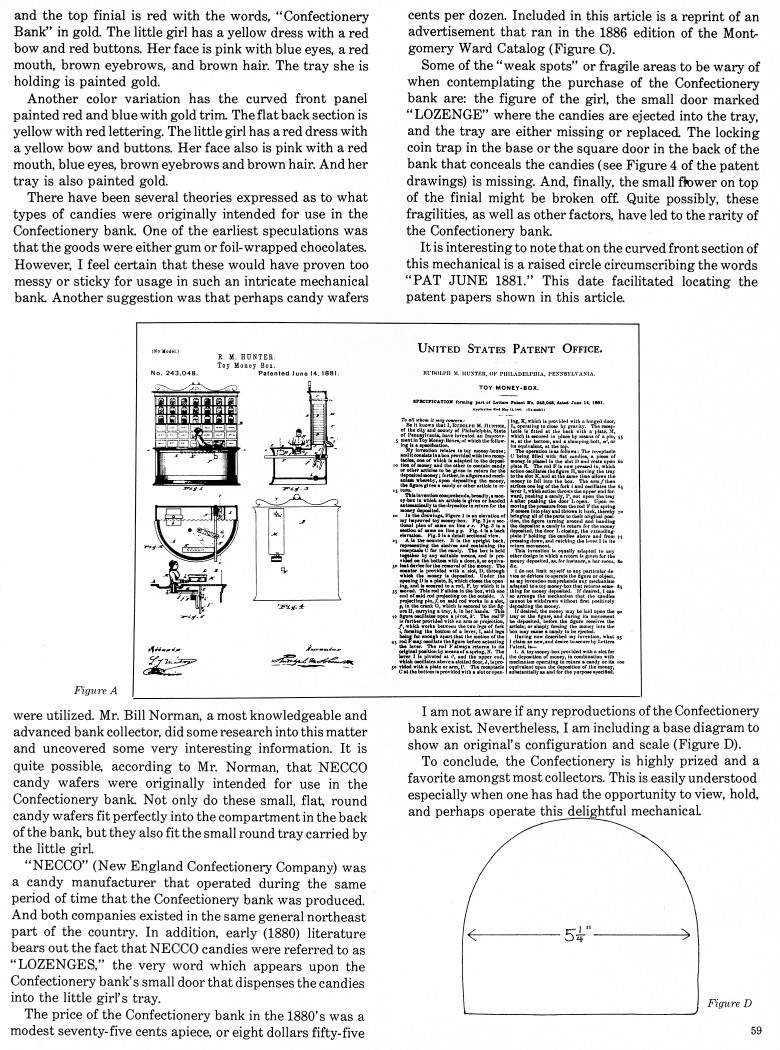|
The Confectionery Bank
by Sy Schreckinger – ANTIQUE TOY WORLD Magazine – November,
1983
The subject of this month's article is quite a
unique mechanical bank Not only does it have the distinction of being
American-made, and constructed from cast iron, but, upon the deposition of
a coin, vends an actual object – a small flat round confectionery: hence,
the name "Confectionery Bank"
On June 14, 1981, Rudolph M. Hunter of Philadelphia, Pennsylvania,
was granted Patent number
243,048 for his design and invention of the
Confectionery bank (Figure A). The bank, as it was eventually manufactured
by the Kyser and Rex Company of Philadelphia, follows those drawings quite
faithfully.
The operation of this mechanical is not only interesting, but very
rewarding to the depositor. A stack of small, flat round candies is
inserted into a compartment at the back of the bank (see Figures 3 and 4
of the patent drawings). A coin is placed into the slot on the counter
top. The plunger on the front of the bank is then pressed. Simultaneously,
the girl holding the tray pivots left a small door marked "LOZENGE" opens,
a bell rings, and the confectionery is deposited into her tray. The girl
returns to her original position (Figure B) with her sweet reward.
The deposited coins are removed by way of a locking coin trap
underneath the base of the bank.
The detail and coloration of the Confectionery bank are extremely
attractive, as is the case with most mechanical banks manufactured by
Kyser and Rex (i.e.. the Bowling Alley; Butting Buffalo; Lion and Monkeys:
Mammy and Baby; Mikado; Organ Grinder and Dancing Bear; and others).
I am not aware of any design variations in the Confectionery bank,
but there are several color variations. One has the curved front panel
painted in shades of dark and light green. trimmed in gold. The molding
at the base and the counter top rim is red. The counter top itself is
yellow with brown wood graining. The back panel is gray with gold
lettering, and the top finial is red with the words, "Confectionery Bank"
in gold. The little girl has a yellow dress with a red bow and red
buttons. Her face is pink with blue eyes, a red mouth, brown eyebrows, and
brown hair. The tray she is holding is painted gold.
Another color variation has the curved front panel painted red and
blue with gold trim. The flat back section is yellow with red lettering.
The little girl has a red dress with a yellow bow and buttons. Her face
also is pink with a red mouth, blue eyes, brown eyebrows and brown hair.
And her tray is also painted gold.
There have been several theories expressed as to what types of
candies were originally intended for use in the Confectionery bank. One of
the earliest speculations was that the goods were either gum or
foil-wrapped chocolates. However, I feel certain that these would have
proven too messy or sticky for usage in such an intricate mechanical bank
Another suggestion was that perhaps candy wafers were utilized. Mr. Bill
Norman, a most knowledgeable and advanced bank collector, did some
research into this matter and uncovered some very interesting information.
It is quite possible, according to Mr. Norman, that NECCO candy wafers
were originally intended for use in the Confectionery bank. Not only do
these small, flat, round candy wafers fit perfectly into the compartment
in the back of the bank but they also fit the small round tray carried by
the little girl.
"NECCO" (New England Confectionery Company) was a candy manufacturer
that operated during the same period of time that the Confectionery bank
was produced. And both companies existed in the same general northeast
part of the country. In addition, early (1880) literature bears out the
fact that NECCO candies were referred to as "LOZENGES," the very word
which appears upon the Confectionery bank's small door that dispenses the
candies into the little girl's tray.
The price of the Confectionery bank in the 1880's was a modest
seventy-five cents apiece, or eight dollars fifty-five cents per dozen.
Included in this article is a reprint of an advertisement that ran in the
1886 edition of the Montgomery Ward Catalog (Figure C).
Some of the "weak spots" or fragile areas to be wary of when
contemplating the purchase of the Confectionery bank are: the figure of
the girl, the small door marked "LOZENGE" where the candies are ejected
into the tray, and the tray are either missing or replaced. The locking
coin trap in the base or the square door in the back of the bank that
conceals the candies (see Figure 4 of the patent drawings) is missing.
And, finally, the small flower on top of the finial might be broken off
Quite possibly, these fragilities, as well as other factors, have led to
the rarity of the Confectionery bank.
It is interesting to note that on the curved front section of this
mechanical is a raised circle circumscribing the words "PAT JUNE 1881."
This date facilitated locating the patent papers shown in this article.
I am not aware if any reproductions of the Confectionery bank exist
Nevertheless, I am including a base diagram to show an original's
configuration and scale (Figure D).
To conclude, the Confectionery is highly prized and a favorite
amongst most collectors. This is easily understood especially when one has
had the opportunity to view, hold, and perhaps operate this delightful
mechanical.
Correction: (from
September, 1985) In the article entitled "The Confectionary Bank," which
appeared in the November 1983 issue of Antique Toy World, it was
erroneously stated: "the Kyser and Rex Company of Philadelphia"; it should
have read; "the Kyser and Rex Company of Frankford."
|


